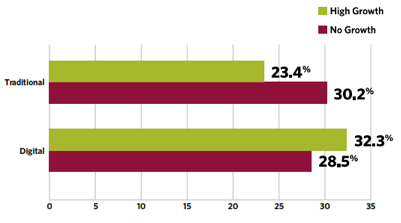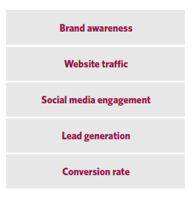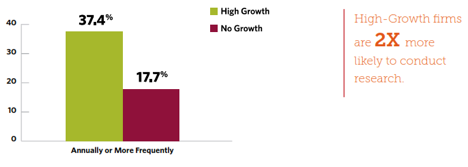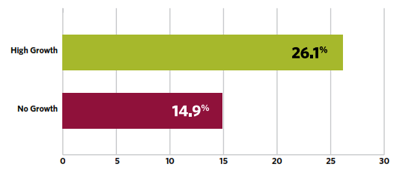Core Strategies for Organic Growth in Accounting and Financial Services Firms
Five Proven Strategies to Generate High Growth
In this article, Hinge Marketing focuses on organic growth and five proven strategies for generating it.
 Accounting and financial services firms have two choices for growth: organic and inorganic. Organic growth is the “Holy Grail” in marketing because it is often elusive and counter-intuitive. However, Hinge’s research reveals there are some strategies that have proven themselves in real-world situations that high-growth firms (those with an average yearly growth rate of at least 20%) adopt.
Accounting and financial services firms have two choices for growth: organic and inorganic. Organic growth is the “Holy Grail” in marketing because it is often elusive and counter-intuitive. However, Hinge’s research reveals there are some strategies that have proven themselves in real-world situations that high-growth firms (those with an average yearly growth rate of at least 20%) adopt.
Organic vs. Inorganic
Organic growth results from having a solid, long-term commitment to expanding the business from within. It emphasizes using current resources, including: skills, knowledge, experience, relationships, and other tools. (Inorganic growth, in contrast, is generated by mergers and acquisitions, as we discuss in another post.)
In this article, we will focus on organic growth—and five proven strategies for generating it.
- Research Your Target Clients
It is surprising how many firms do not develop a clear picture of their ideal client and what motivates their decision-making. The research we conducted for our 2016 High Growth Research Report shows that high-growth firms are twice as likely to conduct systematic research as their no-growth counterparts, and have a growth rate several times higher.
Conducting research also enables firms to focus their marketing based on target clients’ actual needs and preferences, develop high-value service packages, and make a much stronger marketing plan. In addition, it helps firms reduce the risk of marketing missteps and develop a competitive advantage.
- Focus on a Well-Defined Niche
With research results in hand, you can focus on a specific niche. It may seem counter-intuitive to narrow your focus in order to grow, but there are significant benefits to doing so. Concentrating on a well-defined niche reduces marketing costs while increasing market share, fees, and profits. In fact, our studies show that high-growth firms are 75% more likely to have a highly-focused niche.
Firms that offer everything to everybody typically end up offering little real value to anybody—and may eventually become generic commodities, battling with competitors on price alone.
- Develop Strong, Easy-to-Understand Differentiators
A differentiator is a feature or benefit that sets you apart from the competition. For example, an accounting firm might differentiate itself from competitors by focusing on the financial concerns of national chain restaurants—or other specific industries or markets.
Firms with unique differentiators can more easily communicate their value to prospects and, as a result, distinguish themselves from competitors and win more business. Our research revealed that high-growth firms are twice as likely as no-growth ones to have easy-to-understand differentiators. Three qualities increase a differentiator’s value to clients: truth, relevancy, and provability. The best differentiators include provable claims about how a firm’s unique services or expertise can specifically benefit the client. The least effective differentiators, in contrast, are those offering no direct benefit to clients. See also Why Brand Differentiation is Essential for Professional Services Firms to Succeed.
- Balance Traditional and Digital Marketing
High-growth firms have a more balanced marketing mix, spending somewhat less on traditional and more on digital marketing. However, although they invest slightly less money and effort on marketing overall, they actually grow more.
Traditional vs. Digital Marketing Effort

Here is where all that research mentioned earlier comes in handy. Your data will tell you how your target audience prefers to receive information—helping you focus your marketing dollars on the most effective channels.
Tracking your marketing is important, too. High-growth firms commit to tracking their marketing efforts, closely monitoring 33% more variables than slow-growing peers.  Almost every firm tracks such basics as new clients, revenue, and profitability. However, high-growth firms are also more likely to track variables related to the marketing process.
Metrics Most Often Tracked by High-Growth Firms

This additional tracking puts firms in a better position to know what works and what does not—and to make course adjustments in their marketing as needed.
- Make Your Expertise Visible
As a professional services firm, your marketing mission is to persuade potential clients to buy your expertise (to learn more, check out Inside the Buyer’s Brain). But although your expertise has the advantage of being unique to your company, it has a drawback. Potential clients cannot touch it, taste it, smell it, or see it—so the challenge is to make it visible to them.
This can be done through a carefully executed campaign of blogging and article writing, speaking, social media conversations, and search engine optimization. As appropriate personnel within your firm become Visible Experts, the firm as a whole gains value in the eyes of potential clients. This value, properly leveraged, leads directly to a cycle of organic growth, greater visibility, and more business.
Conclusion
There is nothing mysterious about organic growth—it just requires a commitment to doing some homework, discipline, and persistence. Research is key, and the driver of a more powerful strategy, and more efficient and effective marketing.
Lee W. Frederiksen, PhD, is Managing Partner at Hinge, the leading branding and marketing firm for the professional services. Hinge conducts groundbreaking research into high-growth firms and offers a complete suite of services for firms that want to become more visible and grow.
Mr. Frederiksen can be contacted at (703) 391-8870 or by e-mail to LFrederiksen@hingemarketing.com.











